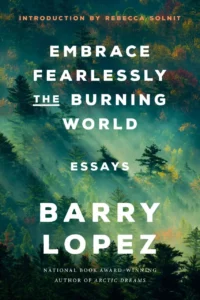In an essay extracted from his final work ‘Embrace Fearlessly the Burning World’, the late, great Barry Lopez considers what is known — and unknowable — about a river.

River
For Cort and Dave
The bed of a river, a geological feature like an arroyo, a canyon, or a wash, freights moving water from high ground to low. The river itself is in the class of flowing waters, which includes the run, the brook, and the kill, but it is distinguished from all these by its greater breadth and by its length. The Mississippi River is 2,340 miles long; and the distance from the mouth of the Mississippi to the headwaters of the Missouri River is 4,880 miles. The mouth of the Columbia is four miles across. Another measure of the river’s primacy among bodies of moving water is how much more often its tributaries are called forks, branches, roots, and prongs, like the Coulter Branch of the Kentucky River in Kentucky, or the North and South Prongs of the Little Red River in Texas, or the Ross Fork of the Judith in Montana, or the Rat Root of Rainy Lake in Minnesota.
The flow of a river is insistent; it carries high water during a flood and low water during a drought, but it does not dry up or disappear like an ephemeral creek or the waters of an arroyo (unless, like the Rio Grande or the Colorado, it is periodically completely drained by irrigation pumps).
The rate of flow of a river might hardly be apparent, as is the case with a back eddy; or wildly rushing, as whitewater tumbling through a dalles; or plain sluggish, sprawling in a leisurely way across the bottomlands of its floodplain. The nature of a river, generally, is to be more obviously relentless on its journey than a creek, to animate to a greater extent the landscapes it moves through, and to grow more stately as it broadens and deepens in its middle reaches. The bass voice of the river can be found in the cataract, in the plunge of a waterfall, and in the hollow cavitation of a rapids; but the river speaks, too, with the susurrations, the gurgle, and the delicate seethe of the narrower and shallower runs of water.
These characteristics are concerned only with the size, the animation, the constancy, and the force of the river, as well as its seeming parenthood in the family of rills, branches, and their kin. It is to say nothing of the beings living comfortably within the river—trout, caddisfly larva, behemoth sturgeon (a kind of once-upon-a-time fish), mussel, dace, and salmon alevin—or of those who fish in them, like the merganser and the great blue heron, or those who sleep on their quiet waters in the evening, the harlequin duck and the mallard, or those who crawl their bottoms like the crayfish, or who reside in their banks like the beaver and the ouzel, or who prowl their quieter water in search of food like the salamander, or who depend on them for life, like the otter.
It is to say nothing of how darkness does not stem their flow, for they are sleepless, or how sunlight lambent on their surfaces strains the human eye, which can find no detail in the molten light and must therefore turn away. It is to say nothing of the sudden clack of cobbles shifting on the river’s bed in the middle of the night, of the way rain hammers the surface flatter, or of how soundlessly it accepts the fall of snow.
It is to say nothing of the trickle of its headwaters or the sigh of its apparent extinction as it unbraids across its delta, or the turbulence and upwelling as it falls into the line of a larger river. It is to say nothing of its cutbanks and gravel bars, its salmon redds, pocket waters, islands, and holes.
This is to say that it is a kind of animal itself, containing other animals and abetting the lives of still others, like the osprey and the mountain lion sipping at its bank. It is to point out that rivers are older than humans, that they endure dams, pollution, and being channeled, and, one way or another, carry on. It is to say that despite our charts of cubic feet of flow per second, our topographic maps of the precise extent of their watersheds, our catalogs of their aquatic, avian, and terrestrial denizens, we hardly know them.
*
‘Embrace Fearlessly the Burning World’ is out now, published by Notting Hill Editions, and is available here (£12.99).